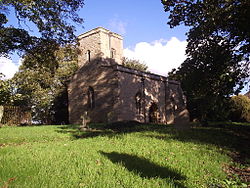Farndish
| Farndish | |
| Bedfordshire, Northamptonshire | |
|---|---|
 Farndish church | |
| Location | |
| Grid reference: | SP925635 |
| Location: | 52°15’43"N, 0°38’46"W |
| Data | |
| Population: | 40 (2001) |
| Post town: | Wellingborough |
| Postcode: | NN29 |
| Dialling code: | 01933 |
| Local Government | |
| Council: | Bedford |
| Parliamentary constituency: |
North East Bedfordshire |
Farndish is a village and ancient parish on the border of Bedfordshire and Northamptonshire. The county border runs down the main street (Irchester Road) with the parish church on the Bedfordshire side. The village lies near the Northamptonshire villages of Irchester and Wollaston and the Bedfordshire village of Wymington. The name Farndish means fern-clad pasture.
Although previously a civil parish itself, today Farndish is within the civil parish of Podington (sometimes called Podington and Hinwick). Much property in the area is owned by the local Saxby family – once famous locally for their pork pies and pastry.
History
Farndish was mentioned in the Domesday Survey as 'Fernadis'.
According to Samuel Lewis:
| “ | Farndish is a parish in the Hundred of Willey, and the county of Bedford, 4½ miles (S.W. by S.) from Higham-Ferrers, containing 73 inhabitants. The church living is a rectory, in the archdeaconry of Bedford, and diocese of Lincoln, rated in the king's books at £10. C. Chester, Esq. was patron in 1784.[1] | ” |
The local author H. E. Bates would often come through the village on his nocturnal walks in the 1920s and 1930s. It was on one of the night walks that he got the inspiration for his first novel, The Two Sisters, when he saw a light burning in a cottage window.
In 1937 The Times reported the plans being made in Farndish to mark the celebrations for the Coronation of King George VI – "a fine example of how England's villages may make this a memorable day in the lives of their people".[2] On Coronation Day each of the twelve houses in the village was to be decorated to represent a different part of the British Empire. In the morning there would be a service in the parish church, for which the parson would come from Podington. "Then", according to The Times, "the population of 45 will adjourn to the village hall to drink the health of the King in ale. Port wine will be supplied to those who are teetotallers, in accordance with a well-known English custom." In the afternoon there were to be sports and games, and in the evening the villagers would return to the village hall for a fancy-dress dance and whist drive.
The church
The church of St Michaels & All Angels appears to have been built sometime between 1180 and 1210. The masonry used to build the church is mainly local rubble along with some rust-coloured ironstone; the window dressings are of local limestone.
The tower was added in the 15th century within the nave and houses three bells:
- Treble – cast by Christopher Grave – 1663
- Second – cast by James Keene – 1625
- Tenor – cast by Newcombe – 1597
The font dates to circa 1200 and is crowned by a 17th-century wooden cover – this is itself covered in 19th-century inscriptions and patterns. The very low pitched roof still has its original 15th-century timberwork.
According to "Kelly's Directory – the church is "a small building of stone, in the Transitional, Early English and later styles, consisting of chancel, nave and a low western tower rising within the nave, and containing 3 bells : the south doorway is a rich example of the Transitional Norman style : a beautiful stained east window was presented by the late Mr. W. H. S. Adcock, of this village, one on the south side by the Rev. Greville Chester, late rector, and there are several other stained windows : in the chancel is a small brass to John Johnston, rector (ob. 1625), being then nearly 100 years old; and there are also inscriptions to the Clark, Adcock and Alderman families : the church plate includes an ancient chalice : there are 69 sittings. The register dates from the year 1587."[3]
- The parish records for the church and village are available on microfiche for the period 1550-1812 from the Bedfordshire Family History Society.
- Since 1970, the Church has not been used for regular worship but remains consecrated; since 1974 it has been opened and cared for by the The Churches Conservation Trust and the donations of visitors. Repairs to the Church have been carried out for the fund by the Bedford architect Victor Farrar.
- There is a healthy population of bats living in the belfry of the church.
References
| ("Wikimedia Commons" has material about Farndish) |
- ↑ "A Topographical Dictionary of England – Samuel Lewis – 1831"
- ↑ "Village links with Empire: Pride of small community". The Times: p. 13. 16 March 1937. http://callisto10.ggimg.com/imgsrv/FastPDF/LT/WrapPDF=contentSet=LT=recordID=0FFO-1937-MAR16-013-F.pdf. Retrieved 22 October 2013.Template:Dead link
- ↑ "Kelly's Directory – Bedfordshire – 1898"